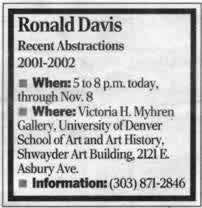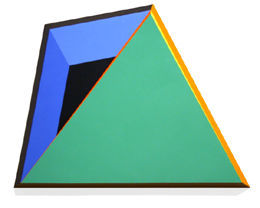Weekend
Spotlite –
Rocky Mountain News, ART – Sept. 13, 2002
 |
|
| Artist Davis back from ‘exile’ with a celebration of shape by Mary Voelz Chandler September 13, 2002
And so it is Ronald Davis' turn. It's not that Davis ever really went away; but the player in the art world of 1960s California left the stage at some point, settling in an isolated outpost in northern New Mexico. Those who knew his work from the old days, when he worked in materials including resin and explored the arena of mathematics and perception, will recognize the hand at work; for everyone else, it's a surprise and a feast. That's because he's back, in a way, with a show of new work opening today in the Victoria H. Myhren Gallery in the School of Art and Art History at the University of Denver. And it is as if this space - an oddity with its long, seven-sided configuration - were made for Davis' work, which through color, line, dimension and form pushes the limit on how we see a piece of art. It is hard-edge abstraction that moves beyond just one edge, with three-dimensional objects that test how colors work together, push apart and fool the eye. Credit here goes to the show's curator, Gwen Chanzit, senior lecturer in modern art and museum studies at DU, as well as a curator in the Denver Art Museum's modern and contemporary department. In one of those chance happenings that fuel the art world, Chanzit met Davis last March during a symposium in Taos examining the work and life of Agnes Martin. On a trip to his studio (several trips, actually), Chanzit saw the potential in bringing Davis' work to DU and Denver. This exhibition marks not only the beginning of the $250,000 endowment funded by Victoria and Trygve Myhren for the gallery, but also the remaking of the gallery lobby, thanks to a separate challenge gift by the couple of $50,000. The lobby is cleaned up and opened up, the gallery in good shape. |
|
 |
|
| Yet it's what's inside that really counts, and that is a selection of digital images by Davis, as well as some two dozen wall pieces made of expanded PVC cut into squares, triangles and other geometric shapes. Davis then assembles them, and through the magic of paint and various textural surfaces, creates shapes that confound and confuse (and amuse). The long, somewhat "bent" shapes he calls hinges, for example, seem to expand and contract on the wall. In some cases, a color can seem to create an indentation; in others, that is achieved by an actual crease or cut. Chanzit has given these hinges, wings and other constructions room to breathe. It is, in short, a test for mind and eye, where Davis becomes the master of illusion in strikingly solid work.
|
|

